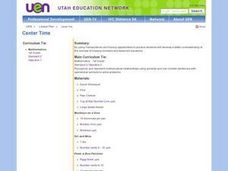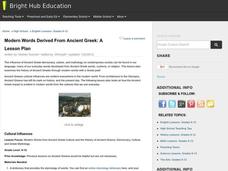Curated OER
What's the Matter with My Snow?
Young scholars collect snow samples around their school. They explore the concepts of density and phase change as well as the math skills of measurement and statistics. Students explore the water cycle through an interactive, down...
Curated OER
A World of Symmetry
Students identify lines of symmetry. In this symmetry lesson, students create objects and identify their lines of symmetry. They answer questions about lines of symmetry. Students cut shapes out of cookie dough and...
Curated OER
Exploring Tessellations
Fifth graders examine how to make tessellations. In this tessellation lesson, 5th graders review the meaning of the word "polygon" while the teacher shows them various examples. They practice making tiling patterns or tessellation's with...
Curated OER
Tessellations
Students identify and construct figures that tessellate. They investigate which regular polygons tessellate and how to modify them to make other tessellating figures. Students explore how naturally occurring tessellations have been...
Curated OER
Chinese Dragons
Students identify where China is in relation to the US. They investigate the history of dragons in Chinese culture. Students explore the nine different parts of a dragon and incorporate them into their own dragon. Student identify the...
Curated OER
Forced Assimilation
Students identify ways that a society promotes assimilation and examine areas where it still occurs in our present culture. They assess the value of assimilation.
Curated OER
Analyzing Civil War Pictorial Envelopes
Students explore the power of political messages contained in visual artifacts and examine the political messages conveyed by the illustrations that appeared on personal stationery used during the Civil War. They create and describe a...
Curated OER
Finding Balance
Young scholars examine the relationships between force, mass and balance through the lens of clay sculpture. They discuss the definitions and concepts behind Newton's Third Law of motion then individually apply these principles to the...
Curated OER
Enough to Make Your Head Spin
Young scholars appreciate the value of nonverbal communication, focusing on the shaking or nodding of one's head, and the meanings attached to each activity in Bulgaria and in the United States. They explain how body language aids...
Curated OER
Center Time
First graders recognize and represent mathematical relationships using symbols and use number sentences with operational symbols to solve problems. They complete various activities such as tug of war, monkeys on a vine, and hit and miss....
Curated OER
Mayor Puts City on Diet to Lose a Million Pounds
Students read a story called Mayor Puts City on Diet to Lose a Million Pounds and answer vocabulary and comprehension questions about it. In this current event Lose a Million Pounds lesson plan, students respond to literature by...
Curated OER
Relative Masses
Students investigate relative mass using 8 different items. In this relative masses lesson plan, students discuss as a class John Dalton's atomic theory. They take the masses of the 8 items and record their data. They discuss relative...
Curated OER
Acids, Bases and Indicators
Young scholars investigate the pH of various solutions with indicators. In this acids, bases and indicators lesson plan, students use a variety of indicators to test solutions for their pH. Young scholars determine which indicators are...
Curated OER
Ancient Greece
Students explore the origins of modern language. In this etymology lesson, students discuss the cultural influences of Ancient Greece on modern society. Students design and complete charts that demonstrate the original and contemporary...
MEP: Demonstration Project
Unit 5 Probability Activities
Wow! Here is a 14-page package of activities to use when your math class is studying probability. There are a myriad of pertinent experiments for learners to try, such as rolling a self-constructed multi-faced three-dimensional...
Curated OER
Measuring Calories in Food
Students measure the amount of calories in food. In this food energy instructional activity, students discuss what a calorie is, how our bodies use a calorie, and how many we need. Then, students use a calorimeter to calculate the amount...
Creative Educator
Dream Room Design
Using the Twist™ application, elementary schoolers design their dream room. They follow the prescribed steps to calculate width, length, perimeter, and surface area in order to create a 2-dimensional representation of their dream room...
Curated OER
Suspension Bridges: Connecting Lives
Middle schoolers explore bridges. For this bridge lesson, students design and build a suspension bridge after visiting related websites and reviewing famous bridges in non-fiction books. Middle schoolers follow the...
Curated OER
Properties of Logarithms
High schoolers explore the concept of logarithms. In this logarithms lesson, students discuss the logarithm properties. High schoolers use linear functions as a basis to develop the logarithm properites by substituting log b...
Curated OER
Death On Board La Belle: Finding Clues from Old Bones
Learners practice analyzing skeletal remains for clues by using the Internet. In this scientific investigation lesson plan, students research the La Belle shipwreck using the Internet and written materials, later completing a...
Curated OER
Beads, Balls, and Beakers
Learners analyze the amount of space required to pack round objects. For this geometry lesson, students practice using space economically by practicing packing spheres into beakers. They then translate this concept to molecules being...
Curated OER
Scenario challenge
Fifth graders become familiar with the geography of New Hampshire and the importance of specific sites in history. In this New Hampshire lesson, 5th graders create a brochure including points of interest and showing distances...
Curated OER
Birth of the Earth
Students examine the major events that have taken place in the Earth's development. In this Earth lesson students view a video and put major events in chronological order.
Curated OER
Animal Coverings
Students read a book. In this animal characteristics instructional activity, students read the book Animal Coverings, answer comprehension questions, and complete a chart where they match animals with their coverings.























